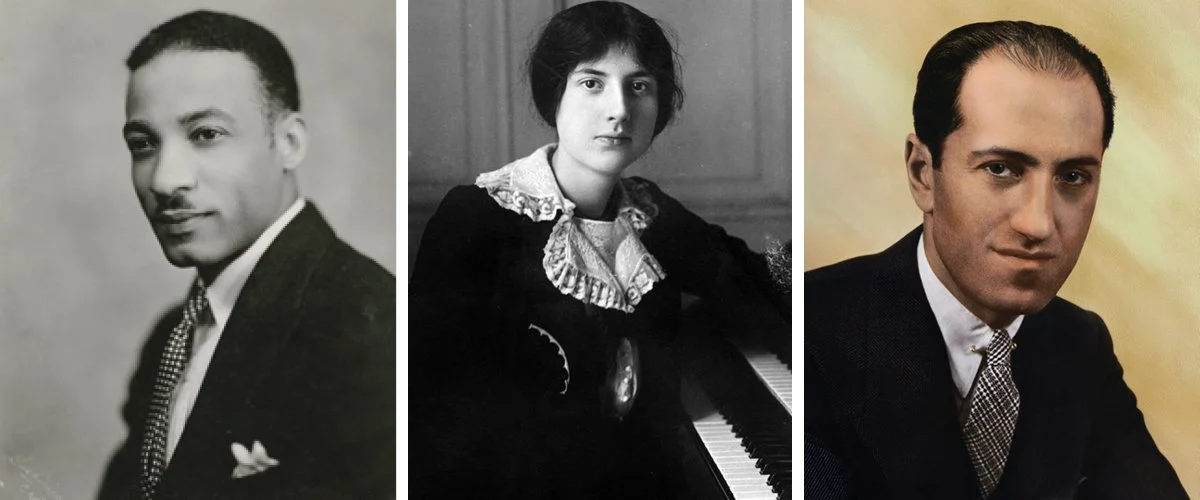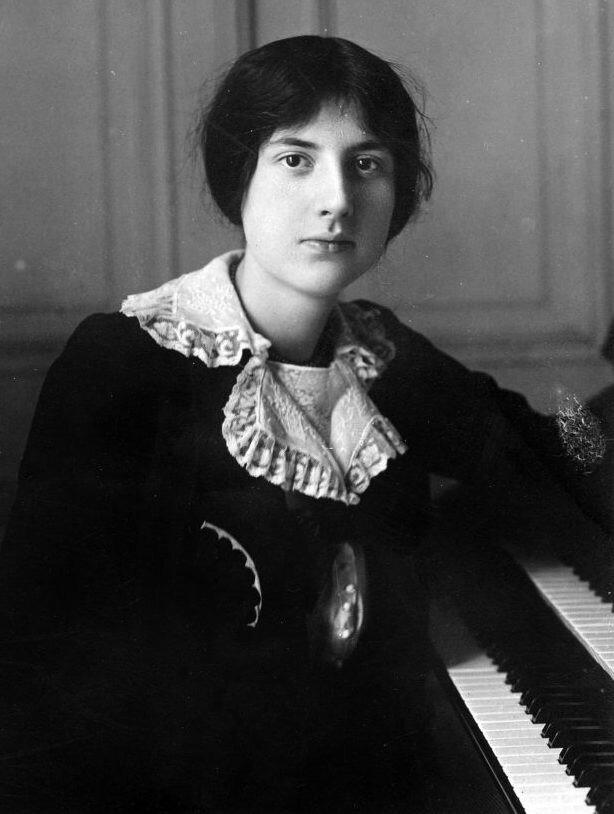Program Notes for February 9 & 10, 2024
Gershwin’s An American in Paris
William dawson
Negro Folk Symphony
Composer: born September 26, 1899, Anniston, AL; died May 2, 1990, Montgomery, AL
Work composed: 1934, rev. 1952
World premiere: Leopold Stokowski led the Philadelphia Orchestra on November 20, 1934, at Carnegie Hall in New York City
Instrumentation: piccolo, 2 flutes, 2 oboes, English horn, 3 clarinets, bass clarinet, 2 bassoons, contrabassoon, 4 horns, 3 trumpets, 3 trombones, tuba, timpani, adawura (Ghanaian bell), African clave, bass drum, chimes, cymbals, gong, snare drum, tenor drum, xylophone, harp, and strings
Estimated duration: 30 minutes
“I’ve not tried to imitate Beethoven or Brahms, Franck or Ravel – but to be just myself, a Negro,” William Dawson remarked in a 1932 interview. “To me, the finest compliment that could be paid my symphony when it has its premiere is that it unmistakably is not the work of a white man. I want the audience to say: ‘Only a Negro could have written that.’”
Two years later, Leopold Stokowski led the New York Philharmonic in the premiere of Dawson’s Negro Folk Symphony. Critics and audiences alike hailed it as a masterpiece. One reviewer declared it “the most distinctive and promising American symphonic proclamation which has so far been achieved,” and another enthused, “the immediate success of the symphony [did not] give rise to doubts as to its enduring qualities. One is eager to hear it again and yet again.” Given this overwhelmingly positive reception, Dawson’s Negro Folk Symphony, which at the time he thought of as the first of several future symphonies, should have been heard “again and yet again.” But it was not. Despite Stokowski’s advocacy for Dawson and the Negro Folk Symphony, and despite the stellar reviews it received at its premiere, within a few years both the music and its composer had faded into relative obscurity. Dawson never composed another symphony, although he did continue writing and arranging music – primarily spirituals, which he preferred to call “Negro folk songs” – for the rest of his long career.
In the current climate of racial reckoning, Dawson’s Negro Folk Symphony is enjoying a long-overdue revival, as is the music of other Black classical composers such as Florence Price, William Grant Still, Nathaniel Dett, and many others.
Dawson wrote that his symphony was “symbolic of the link uniting Africa and her rich heritage with her descendants in America,” and gave each of its three movements a descriptive title. Dawson explained in his own program note: “The themes are taken from what are popularly known as Negro Spirituals. In this composition, the composer has employed three themes taken from typical melodies over which he has brooded since childhood, having learned them at his mother’s knee.” Musicologist Gwynne Kuhner Brown observes, “The themes are handled with such virtuosic flexibility of rhythm and timbre that each movement seems to evolve organically,” creating a “persuasive musical bridge between the ‘Negro Folk’ and the ‘Symphony.’”
In “The Bond of Africa,” Dawson opens with a horn solo. The dialogue between the horn and the orchestra echoes the call-and-response format of most spirituals. The horn solo repeats, usually in abbreviated form, several times throughout this movement, and serves as a musical “bond” holding the work together. The central slow movement, “Hope in the Night,” also features a unifying solo. Here an English horn sounds Dawson’s own spiritual-inspired melody, which he described as an “atmosphere of the humdrum life of a people whose bodies were baked by the sun and lashed with the whip for two hundred and fifty years; whose lives were proscribed before they were born.” Underneath the plaintive tune, the orchestra provides a dirge-like accompaniment that builds to an ominous repetition of the solo for tutti orchestra. This episode is offset by an abrupt change of mood, and we hear a lighthearted, up-tempo reworking of the original tune (the “hope” of the movement’s title). These two contrasting interludes alternate throughout the rest of the movement. Towards the end, Dawson reworks the harmony, which has been grounded in minor keys up to this point, and tiptoes towards major tonalities without fully embracing them. Musically, this device works as a powerful metaphor for the importance and elusive nature of hope to sustain people through traumatic circumstances.
The closing section, “Oh, Le’ Me Shine, Shine Like A Morning Star!” imagines a world in which the hopes of the previous movement are fully realized. Dawson creates this musical utopia through rhythm. The central melody showcases accented off-beat exclamations from various solo instruments and sections throughout, as the rhythms layer increasingly complex parts over one another. Dawson revised this movement in the early 1950s after he encountered the intricate polyrhythms of West African music during a trip to Africa. The interlocking parts and the sounds of African percussion instruments captured Dawson’s ear; when he returned to America, he added these elements. Eventually all these rhythmic strands come together in a final buoyant exclamation.
Lili Boulanger
D’un matin de printemps (From A Spring Morning)
Composer: born August 21, 1893, Paris; died March 15, 1918, Mézy-sur-Seine
Work composed: 1917-18. Boulanger made arrangements in multiple versions: for violin and piano, string trio, and full orchestra
World premiere: undocumented
Instrumentation: piccolo, 2 flutes, 2 oboes, English horn, 2 clarinets, bass clarinet, 2 bassoons, contrabassoon, 4 horns, 2 trumpets, 3 trombones, tuba, bass drum, castanets, cymbals, tambourine, tam-tam, timbales, triangle, celeste, harp, and strings
Estimated duration: 5 minutes
Women composers, like other female creative artists, have to fight battles their male counterparts do not. Even today, a female visual artist, writer, or composer is sometimes evaluated on criteria that have little or nothing to do with her work, and everything to do with her gender, her appearance, or her life circumstances. Lili Boulanger was no exception.
The younger sister of composer and pedagogue Nadia Boulanger, who taught composition to many of the 20th century’s most distinguished composers, Lili Boulanger revealed her enormous talent at a very young age. She was a musical prodigy born into a musical family; in 1913, at age 20, she became the first woman to win the coveted Prix de Rome, France’s most prestigious composition prize. Boulanger’s compositional style, while grounded in the prevailing impressionistic aesthetics associated with Claude Debussy, is nonetheless wholly her own. Her music features rich harmonic colors, hollow chords (open fifths and octaves), ostinato figures, running arpeggios, and static rhythms.
Along with her tremendous musical ability, Boulanger was born with a chronic, debilitating intestinal illness, probably Crohn’s disease. Today there are drugs and other therapies to manage this condition, but in Boulanger’s time the illness itself had neither name nor cure, and its treatment was likewise little understood. Throughout her short life, Boulanger suffered from acute abdominal pain, bouts of uncontrollable diarrhea, and constant fatigue; all these symptoms naturally impacted her stamina and her ability to write. Contemporary reviews of Boulanger’s work always emphasized her physical fragility, often in lieu of a thoughtful assessment of her music.
Despite illness, Boulanger continued composing, even on her deathbed. D’un matin printemps, the second half of a diptych that includes its shorter counterpart D’un soir triste (From a Sad Evening) are two of the last works she wrote. Both pieces treat the same opening melodic and rhythmic theme in different ways: in D’un soir triste, the tempo is slow and the mood elegiac, while the same melodic/rhythmic fragment receives a cheerful, puckish treatment in D’un matin printemps that sparkles with effervescence and youthful joy.
George gershwin
An American in Paris
Composer: born September 26, 1898, Brooklyn, NY; died July 11, 1937, Hollywood, CA
Work composed: March - June 1928, while Gershwin and his siblings were vacationing in Paris
World premiere: Walter Damrosch led the New York Philharmonic on December 13, 1928 in New York
Instrumentation: 3 flutes (1 doubling piccolo), 2 oboes, English horn, 2 clarinets, bass clarinet, 3 saxophones (alto, tenor, baritone), 2 bassoons, 4 horns, 3 trumpets, 3 trombones, tuba, timpani, bass drum, bells, cymbals, snare drum, taxi horns, tom-toms, triangle, xylophone, celesta, and strings
Estimated duration: 17 minutes
“My purpose here is to portray the impression of an American visitor in Paris, as he strolls about the city and listens to various street noises and absorbs the French atmosphere,” wrote George Gershwin about his tone poem, An American in Paris. “As in my other orchestral compositions, I’ve not endeavored to represent any definite scenes in this music. The rhapsody is programmatic only in a general impressionistic way, so that the individual listener can read into the music such as his imagination pictures for him,” This highly evocative, colorful symphonic music expertly captures the sights and sounds of Paris as its American protagonist wanders through the city streets. To illustrate the American’s journey, Gershwin included several of what he termed “walking themes,” which recur throughout the work. The trumpet sounds the most recognizable of these, the “homesick music,” in a bluesy solo. The “American” section concludes with an up-tempo Charleston played by a pair of trumpets, and the walking themes return. Finally, the orchestra winds up with a glittering exuberant finale as night falls on the City of Light.
An American in Paris marked a breakthrough for Gershwin as a composer, as the first symphonic piece for which he created his own orchestrations. When Rhapsody in Blue premiered in 1924, Gershwin was criticized because the Rhapsody’s orchestral version was created by Ferde Grofé. Four years after Rhapsody’s premiere, with An American In Paris, Gershwin demonstrated his growing command of orchestral colors, effectively silencing his detractors.
© Elizabeth Schwartz
NOTE: These program notes are published here by the Modesto Symphony Orchestra for its patrons and other interested readers. Any other use is forbidden without specific permission from the author, who may be contacted at www.classicalmusicprogramnotes.com




















